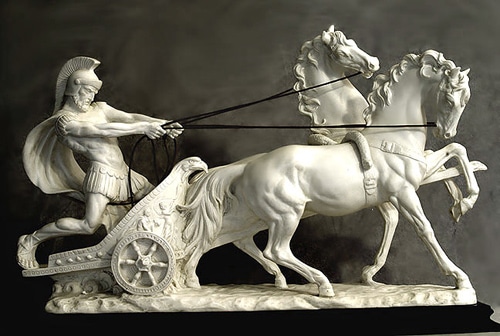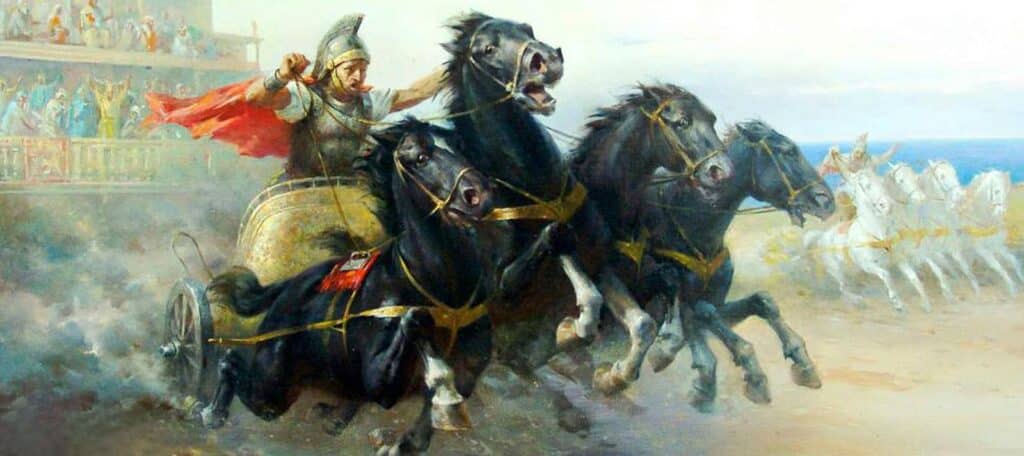In a world where modern athletes like Michael Jordan, LeBron James, or Mike Tyson capture headlines and acquire massive fortunes, there exists a historical figure whose wealth and fame dwarf even the most celebrated sports icons of our time.
His name was Gaius Appuleius Diocles. He was a legendary Roman charioteer whose fortune remains unrivaled. He became one of the highest-paid athletes in world history.
Diocles was renowned for his unbelievably sizable wealth. He transcended the boundaries of his era. His earnings estimates add up to a staggering fortune that would rival even the most prosperous individuals in the ancient world.
Incredibly, it would even make modern athletes’ billion-dollar endorsement deals look pitifully small in comparison.
Through the thunderous roar of the Roman circus, Diocles navigated his chariot through perilous races. He seized victory after victory.
The story of Gaius Appuleius Diocles is centered on the fascinating intersection of sports, wealth, and fame. It unveils the enigma behind his rise to prominence, delving into his early life, astounding racing achievements, and the lavish rewards that accompanied his success.
Embark on a journey to ancient Rome as we uncover the legacy of Gaius Appuleius Diocles and the enduring allure of the wealthiest athlete of all time.

The Roman Circus and Chariot Racing
In ancient Rome, grand spectacles unfolded before the eyes of a quarter-million fervent spectators. The Circus Maximus was the center of entertainment.
This colossal chariot-racing stadium surpassed all other sporting events in popularity. It eclipsed even the allure of gladiatorial combat and naval battles.
It became the gathering place for the masses. It drew both awe and deep chagrin from playwrights whose stage plays paled in comparison.
As the racing enthusiasts converged upon the Circus Maximus, an air of anticipation filled the atmosphere. Spectators would arrive the night before, vying for prime seats to witness the heart-stopping races.
The chariot drivers typically hailed from the lower echelons of society. They were aligned with teams that represented businesses that invested heavily in horse training and equipment upkeep. The drivers donned vibrant team jerseys, sporting the names of the Reds, Blues, Whites, and Greens.
They were often armed with leather helmets, shin guards, chest protectors, whips, and curved knives for self-defense and strategic maneuvers. Races would commence with the drop of the emperor’s napkin, while referees attempted to maintain order from horseback.
In a display of skill, bravery, and sheer determination, the charioteers navigated their four-horse chariots through seven savage laps around the stadium. The victors of these exhilarating races would ascend to legendary status, like today’s star athletes.
One among them, in particular.
Early Life and Racing Career
Gaius Appuleius Diocles was born in 104 AD. He hailed from the Roman province of Lusitania (Portugal). He entered the exhilarating world of chariot racing at the tender age of 18, in the year 122 AD.
His early races with the Whites racing stable yielded no victories. But it wasn’t long before Diocles showcased his exceptional talent and began etching his name into the annals of racing history.
Diocles quickly became a mainstay at the Circus Maximus, where he built his illustrious career.
From early on it was clear that his specialty was the singles races. This was a race type that captivated both drivers and spectators alike. Drivers competed individually instead of as teams and relied on their own skill and a touch of luck.
He had stints with both the Whites and Greens before finding his home with the Reds. He mesmerized audiences with his signature move—a powerful final dash.
In all, Diocles won an astonishing 1,064 times in the singles category alone. He emerged victorious in an incredible 1,462 out of 4,257 four-horse chariot races. This secured his status as a racing legend.
Notably, he dominated the prestigious race that followed the grand ceremonial opening procession. This was known as the Pompa circensis. He won this an astonishing 110 times.

Diocles’ Success and Wealth
Gaius Appuleius Diocles achieved unparalleled success and amassed a staggering fortune during his illustrious, record-shattering career. He competed for a remarkable 24 years and left a powerful mark on the sport and the whole of the Roman Empire.
He also emerged in the aftermath as what some historians have considered to be the highest-paid athlete of all time.
In total, Diocles accumulated a mind-boggling sum of 35,863,120 sesterces in career earnings. This was evidenced by an engraving on a monumental inscription erected in Rome.
It’s uncertain exactly how much of these earnings Gaius would have been paid directly. Slave-charioteers would have had their winnings kept by their management teams, and Diocles’ status is unknown to modern historians.
Either way, this astounding wealth would have surpassed the career earnings of the highest-paid provincial governor. It was technically enough to provide grain for the entire city of Rome for a whole year.
By today’s standards, his prize money would equate to approximately $15 billion USD, a remarkable feat of financial success.
Diocles’ Legacy and Impact
Diocles’ enduring career spanned affiliations with three of the most renowned chariot racing stables in Rome: the Whites, Greens, and Reds.
He had a brief and less successful stint with the Green team. There, his opportunities were restricted. But Diocles thrived during his 15-year tenure with the Reds.
His accomplishments on the track, combined with his incomparable earnings, solidified his status as a racing legend. Upon retiring at the age of 42, Diocles retreated to the opulent town of Praeneste to enjoy the fruits of his extraordinary wealth.
After Gaius Appuleius Diocles raced his last chariot at the age of 42, his legacy as a sporting icon endured.
His influence extended beyond the racing track. He captured the imagination of poets and artists who immortalized his exploits through their works. Graffiti artists even scrawled crude renderings of his face on walls throughout the Mediterranean.
His achievements were so remarkable that even today, as we’ve mentioned, it is likely that Diocles is the highest-paid athlete of all time.
Moreover, his story serves as a window into the extravagant and awe-inspiring spectacles of ancient Rome. His incomparable wealth and fame showcased the immense popularity and cultural significance of chariot racing in Roman society.
As the greatest charioteer of his time, Gaius Appuleius Diocles left an enduring legacy that continues to fascinate and captivate modern readers and historians.
References
Lorenzi, Rossella. “Richest Athlete Hailed from Ancient Rome.” NBCNews.com, September 1, 2010. https://www.nbcnews.com/id/wbna38957186.
Struck, Peter. “Greatest of All Time.” Lapham’s Quarterly, August 2, 2010. https://www.laphamsquarterly.org/roundtable/greatest-all-time.
Zarley, B. David. “The Fifteen Billion Dollar Athlete.” VICE, March 23, 2015. https://www.vice.com/en/article/nzpgaq/the-fifteen-billion-dollar-athlete.

